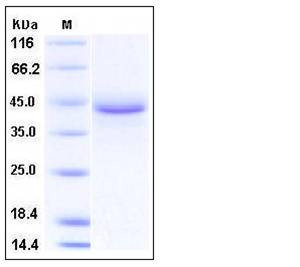Human LRPAP1 / A2MRAP Protein (His Tag)
A2MRAP,A2RAP,alpha-2-MRAP,HBP44,MRAP,MYP23,RAP
- 100ug (NPP4062) Please inquiry
| Catalog Number | P11100-H08H |
|---|---|
| Organism Species | Human |
| Host | Human Cells |
| Synonyms | A2MRAP,A2RAP,alpha-2-MRAP,HBP44,MRAP,MYP23,RAP |
| Molecular Weight | The secreted recombinant human LRPAP1 consists of 334 amino acids with the predicted molecular mass of 39.2 kDa. As a result of glycosylation, rh LRPAP1 migrates as an approximately 43 kDa band in SDS-PAGE under reducing conditions. |
| predicted N | Tyr 35 |
| SDS-PAGE |  |
| Purity | > 92 % as determined by SDS-PAGE |
| Protein Construction | A DNA sequence encoding the human LRPAP1 (NP_002328.1) (Tyr 35-Leu 357) was expressed, fused with a signal peptide at the N-terminus and a polyhistidine tag at the C-terminus. |
| Bio-activity | Measured by its binding ability in a functional ELISA . Immobilized human LRPAP1 at 0.5 μg/ml can bind human VLDLR with a range of 3.2-400 ng/ml. |
| Research Area | Cancer |Signal transduction |Other Related Intracellular Topics |Cellular Senescence and Pathways in Aging |Wnt Family |Wnt Receptors | |
| Formulation | Lyophilized from sterile PBS, pH 7.4 1. Normally 5 % - 8 % trehalose, mannitol and 0.01% Tween80 are added as protectants before lyophilization. Specific concentrations are included in the hardcopy of COA. |
| Background | Receptor-associated protein (RAP) is a molecular chaperone for low density lipoprotein receptor-related protein (LRP), which plays a key role in cholesterol metabolism. The lipoprotein receptor-related protein (LRP) is an endocytic receptor for several ligands, such as alpha2-macroglobulin (alpha2 M) and apolipoprotein E. LRP is involved in the clearance of lipids from the bloodstream and is expressed in the atherosclerotic plaque. The LRP-associated protein (LRPAP in humans, RAP in mice) acts as a chaperone protein, stabilizing the nascent LRP peptide in the endoplasmic reticulum and Golgi complex. Alpha-2-macroglobulin receptor-associated protein, also known as low density lipoprotein receptor-related protein-associated protein 1, RAP and LRPAP1, is a 39 kDa protein and a member of the alpha-2-MRAP family. It is a receptor antagonist that interacts with several members of the low density lipoprotein (LDL) receptor gene family. Upon binding to these receptors, LRPAP1 inhibits all ligand interactions with the receptors. LRPAP1 is present on cell surface forming a complex with the alpha-2-macroglobulin receptor heavy and light chains. It binds with LRP1B and the binding is followed by internalization and degradation. LRPAP1 interacts with LRP1/alpha-2-macroglobulin receptor and LRP2 (previously called glycoprotein 330), and may be involved in the pathogenesis of membrane glomerular nephritis. LRPAP1 together with LRP2 forms the Heymann nephritis antigenic complex. LRP2 is expressed in epithelial cells of the thyroid, where it can serve as a receptor for the protein thyroglobulin. Intron 5 insertion/deletion polymorphism of RAP gene (LRPAP1) has been implicated in other diseases sharing etiology with gallstone disease (GSD). The LRPAP1 insertion/deletion polymorphism influences cholesterol homeostasis and may confer risk for gallstone disease and gallbladder carcinoma (GBC) incidence usually parallels with the prevalence of cholelithiosis. The genetic variations at the LRPAP1 locus may modulate Alzheimer disease (AD) phenotype beyond risk for disease. In addition, the variation at the LRPAP1 gene could contribute to the risk of developing an early episode of myocardial infarction (MI). |
| Reference |
